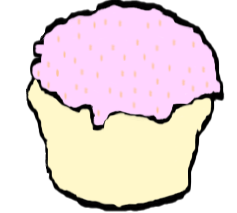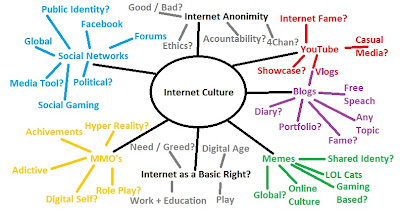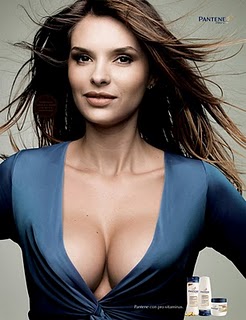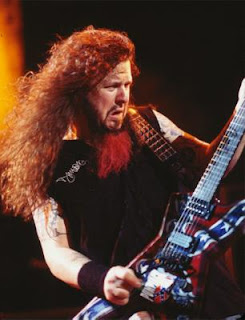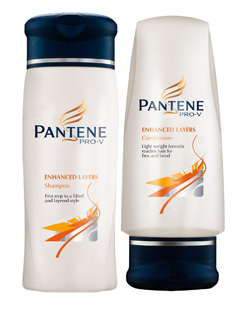Paul Willis says “We are all cultural producers in some way…” this is more and more relevant as we become more technically advanced as a culture. My images are digital manipulations. I would not have been able to construct them without both the wider availability of development software like Photoshop or the Internet. “There is now a whole social and cultural medium of inter-webbing common meaning and identity making”… (Willis, 1990). Due to the Internet we are now sharing more, we share every aspect of our cultures and walk away with parts we like of other cultures. This amazing melting pot results in the fusion and rejection of certain ‘grounded aesthetics’ and also leads to the creation of new ones. No longer do we have to accept that culture is a one-way flow, we can take the message, change it and then send it back.
Pantene Pro-V adverts are the epitome of adverts for hair products (shampoos, conditioners and serums etc) because of their layout and style. Their adverts as such are very effective. This is achieved by combining something unique and original (such as their ‘The Haircare Collection’ campaign featuring a woman’s hair as her clothes) with the recognised media standard. Their print ads normally are arranged with the product being actually quite small and therefore not the main focus of the ad. They will normally include a small product logo (placed most often to the upper right) and this further adds to the supposed credibility of the product and promotes the ‘brand’ culture of the modern consumer. The main focus of the print ad will be a ‘pretty’ woman with shiny and healthy looking hair. This trick is more about selling consumers the lifestyle rather than the product. It is so effective that most hair and beauty ads and even perfume ads work in a similar way – you too can become as ‘pretty’ and ‘desirable’ as this person if you buy our product. This psychological tactic is largely aimed at women, however it works equally well on men. Also, more often than not, a slogan will be included to further draw a potential customer’s interest.
My idea for manipulating a Pantene Pro-V advert came originally from a joke with a friend, about a mutual friend of ours who was always primping and preening his extremely long hair. Long hair conformed to the ‘grounded aesthetics’ of the ‘heavy metal’ subculture he allied himself with. As a result of the joke, the idea for Pantera Pro-V was born. I personally thought that to make a parody of existing Pantene Pro-V product advertisements related a lot to the writing of Paul Willis. I have taken two ‘symbolic materials’ from general culture and re-worked them, generating new ‘lower culture’ and challenging the notions and stereotypes of the media driven ‘general culture’ as a result.
The first task I wanted to complete was making the new logo. A product’s logo represents a company image and brand. Paul Willis comments “these symbolic elements rely absolutely for their human values and meanings on shared symbols in communicative codes.” Just by looking at a logo a consumer is bombarded by everything associated with the company or product in question. This includes the presumed quality of the product, its intended market and the company’s ethics etc. In today’s extremely brand driven consumer culture, a logo often sells on its own, such as Nike’s tick and the MacDonald’s golden M. Therefore, I felt that the logo was paramount to my adverts and had to be believable and of a good quality.
I achieved this by effectively ‘fusing’ the logo of Pantene’s shampoo with the logo of the metal band Pantera. It occurred to me that the image would perhaps only work if the cultural references were known. This would restrict the number of viewers who understood the spoof inherent in the pictures. I then carried out research and based upon feedback, I was reassured that most people would understand it was a spoof or parody, even if they didn’t actually know the band Pantera.
My aim was to make the adverts look as believable as possible. However, I wanted to pay close attention to the humour involved. Humour has played an important part in advertising since at least 1790. (C.S Gulars & M.G Weinberger, 2006) Its main function is to create the feeling of rapport with the consumer and also to engage them; an advert that engages the consumer is much more likely to lead to the product selling. The humour I have employed functions on several levels; metal band members usually have long hair (as do the fans), which ties in nicely with a hair product. A metal band’s image is the antithesis of hair product placement, which is generally associated with stereotypically attractive women. The Pantera logo for their album ‘Reinventing Hell’ (which I used to create the new logo) has skulls embedded in the lettering, which I found deviously ironic, as skulls do not have hair! Finally, the ‘Reinventing Hell’ slogan very easily transformed in my head into ‘Reinventing Hair’ which is a perfect slogan for a hair ad campaign.
Slogans are often a crucial part of an ad campaign, examples are L’Oreal’s “because you’re worth it” and Pantene’s “for hair that shines” both of which I have played with to create new slogans for my ads. I have woven together inputs from the ‘metal’ subculture and the hair advertising industry, using both album titles of the band itself and some terms that relate to subculture and known slogans associated with hair products. I would hope that the familiarity inherent in these slogans would not only add to the humour of the adverts but also carry over some of the connotations of the old slogans and thus be more believable. This psychological tactic is often used to sell fakes such as supposed Rolex watches etc. I have also chosen the font of the slogans carefully to reflect the visual preferences of the ‘rock’ and ‘Goth’ subcultures. I have seen tattoos upon people that conform to these subcultures that are very similar to the fonts I have used. By conforming to the ‘grounded aesthetics’ of the alternative subcultures at least in part in the adverts its makes them much more appealing to the same kinds of audience that would enjoy Pantera’s music.
I wanted my adverts to look unified and function as an actual ad campaign. To achieve this I chose to stick to a colour palette influenced by fire and darkness (stereotypically associated with ‘rock’ and ‘metal’). Fire has both negative and positive connotations. It is vital and warm, yet also dangerous and wild. It is considered vaguely masculine although in my opinion it is fairly gender neutral. The blacks and greys are much more from the gothic influence, as mostly all alternative genres overlap to some degree in both style and music and as such they share common grounded aesthetics.
The images were created by finding pictures that I thought were relevant and eye-catching using Google image search, then adding my logo and product bottles, which were made by replacing their original logos with the new one. The adverts vary in their complexity and level of manipulations. I constructed them in Photoshop utilising the magnetic lasso tool and the blur tool to great effect.
By using two opposed segments of culture, these adverts allow for the possibilities of new identities to form. Also, they challenge existing stereotypes around metal music bands and followers. (Why shouldn’t a metal fan take care of their hair?) The use of humour in the form of subversion poses deeper questions about our construction of identity. “Finding and holding an identity in common culture is a risky business”…(Willis, 1990). This risk only increases as society becomes more flooded with media advertising; it’s hard to be steadfast in your identity whilst being constantly fed multiple sensory inputs. The media feeds into our ‘peer pressure’ culture, which feeds back into the media. This combination furthers paranoia about achieving the perceived ideal. This in effect, becomes the basis of the ‘grounded aesthetics’ of not only the youth as a whole, but also the individual sub categories that spring up around inputs such as music and fashion.
I hope that my adverts challenge gender stereotypes, as ‘metal’ is usually seen as less attractive to females, being almost exclusively a male dominated sub-culture. Having said that, I know a fair amount of females that do like both ‘metal’ music and its associated dress code. One thing of note about Pantene Pro-V is that it is very good for darker hair types, which are often associated with the metal subculture and others similar to it.
In the ‘cowboy from hell’ advert I wanted to really play with juxtaposition. I feel it works on many levels; there is a ‘wholesome’ looking girl (who conforms to the hair advertising norms because she is non threateningly pretty, has a nice big smile and lots of healthy looking hair) with the image of hell. Also there is a juxtaposition of gender because although the slogan states that you can be a cowboy the model is clearly a female. (Why can’t girls be cowboys from hell too?) I felt that she tied in nicely with the Wild West theme however because she is wearing a Stetson, which is strongly associated with the whole cowboy culture both new and old. I also found an image of ‘hell’ that I felt looked like a desert to further reinforce the theme.
“We need cultural entrepreneurs, not cultural detectives.” (Willis, 1990) In my generation it is vastly easy to be a cultural entrepreneur owing to the computer age. It will become more and more prevalent in subsequent generations as software and hardware becomes more sophisticated and more available, also as the youth culture as a whole becomes less and less willing to be merely spoon-fed their culture. They want to play with it and own it; they are much more likely to rebel and change ‘proper’ or ‘meant’ meanings of inputs they are given. However I feel that cultural detection is implicitly involved in this process because if there is no detection of culture as base for the changing of ‘made messages’ then there is simply no platform to work from. Nothing can be produced without prior understanding. To make an advert contextually relevant there has to be an intricate understanding of the cultural notions and associations of everything in the advert. Even down to colour, every aspect of an advert has to be analysed to make sure that it is achieving its aims. The advertising industry has to use more and more subtle devices in its eternal psychological war with the consumer to squeeze every drop of money it can.
“No marketer or advertiser can determine, though they may certainly seek to influence, the ‘message-making’ of our consumption.” (Willis, 1990) It is this desire to influence a consumer that makes market research so vital, this cultural detection is so massively important that an advert could fail if it is not conducted well. This is also true of my adverts, no matter how realistic I want them to appear or what I want them to achieve it is never guaranteed. However a vast amount of research into, at the very least, the most relevant aspects of the culture the adverts are intended for is the only way to attempt to safeguard the intended meaning.
I have enjoyed the process of making these adverts, as it was a good opportunity to polish my skills in Photoshop. I feel I have achieved what I intended to with my images as they look like they could be real yet they are also very amusing and derisive.
Works Cited
C.S Gulars & M.G Weinberger. (2006). Humor in Advertising; a Comprehensive Analysis. New York, U.S.A: M.E Sharpe Inc.
Willis, P. E. (1990). Common Culture: Symbolic Work & Play in the Everyday Cultures of the Young. Milton Keynes, England: Open University Publishing.

